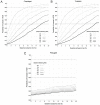P2Y12 Inhibitor Pre-Treatment in Non-ST-Elevation Acute Coronary Syndrome: A Decision-Analytic Model
- PMID: 27548237
- PMCID: PMC4999792
- DOI: 10.3390/jcm5080072
P2Y12 Inhibitor Pre-Treatment in Non-ST-Elevation Acute Coronary Syndrome: A Decision-Analytic Model
Abstract
Current guidelines recommend initiation of a P2Y12 inhibitor for all patients with non-ST-elevation acute coronary syndrome (NSTE-ACS) at the time of diagnosis (pre-treatment); however, there are no randomized trials directly comparing pre-treatment with initiation at the time of angiography to support this practice. We explore clinical and institutional parameters potentially associated with benefit with this strategy in a decision-analytic model based on available evidence from randomised trials. A decision analysis model was constructed comparing three P2Y12 inhibitors in addition to aspirin in patients with NSTE-ACS. Based on clinical trial data, the cumulative probability of 30 day mortality, myocardial infarction (MI) and major bleeding were determined, and used to calculate the net clinical benefit (NCB) with and without pre-treatment. Sensitivity analysis was performed to assess the relationship between NCB and baseline ischemic risk, bleeding risk, time to angiography and local surgical revascularization rates. Pre-treatment with ticagrelor and clopidogrel was associated with a greater than 50% likelihood of providing a >1% increase in 30 day NCB when baseline estimated ischemic risk exceeds 11% and 14%, respectively. Prasugrel pre-treatment did not achieve a greater than 50% probability of an increase in NCB regardless of baseline ischemic risk. Institutional surgical revascularization rates and time to coronary angiography did not correlate with the likelihood of benefit from P2Y12 pre-treatment. In conclusion, pre-treatment with P2Y12 inhibition is unlikely to be beneficial to the majority of patients presenting with NSTE-ACS. A tailored assessment of each patient's individual ischemic and bleeding risk may identify those likely to benefit.
Keywords: cardiac catheterization and angiography; non-ST segment myocardial infarction; percutaneous coronary intervention.
Figures




Similar articles
-
Meta-Analysis of Comparison of the Newer Oral P2Y12 Inhibitors (Prasugrel or Ticagrelor) to Clopidogrel in Patients With Non-ST-Elevation Acute Coronary Syndrome.Am J Cardiol. 2015 Sep 1;116(5):809-17. doi: 10.1016/j.amjcard.2015.05.058. Epub 2015 Jun 4. Am J Cardiol. 2015. PMID: 26119655 Review.
-
Precatheterization Use of P2Y12 Inhibitors in Non-ST-Elevation Myocardial Infarction Patients Undergoing Early Cardiac Catheterization and In-Hospital Coronary Artery Bypass Grafting: Insights From the National Cardiovascular Data Registry®.J Am Heart Assoc. 2017 Sep 22;6(9):e006508. doi: 10.1161/JAHA.117.006508. J Am Heart Assoc. 2017. PMID: 28939715 Free PMC article.
-
Clinically significant bleeding with low-dose rivaroxaban versus aspirin, in addition to P2Y12 inhibition, in acute coronary syndromes (GEMINI-ACS-1): a double-blind, multicentre, randomised trial.Lancet. 2017 May 6;389(10081):1799-1808. doi: 10.1016/S0140-6736(17)30751-1. Epub 2017 Mar 18. Lancet. 2017. PMID: 28325638 Clinical Trial.
-
Effect of prasugrel pre-treatment strategy in patients undergoing percutaneous coronary intervention for NSTEMI: the ACCOAST-PCI study.J Am Coll Cardiol. 2014 Dec 23;64(24):2563-2571. doi: 10.1016/j.jacc.2014.08.053. J Am Coll Cardiol. 2014. PMID: 25524333 Clinical Trial.
-
Pre-treatment with P2Y12 inhibitors in ACS patients: who, when, why, and which agent?Eur Heart J. 2016 Apr 21;37(16):1284-95. doi: 10.1093/eurheartj/ehv717. Epub 2015 Dec 27. Eur Heart J. 2016. PMID: 26712838 Review.
References
-
- Yusuf S., Zhao F., Mehta S.R., Chrolavicius S., Tognoni G., Fox K.K. Clopidogrel in unstable angina to prevent recurrent events trial, I. Effects of clopidogrel in addition to aspirin in patients with acute coronary syndromes without ST-segment elevation. N. Engl. J. Med. 2001;345:494–502. - PubMed
LinkOut - more resources
Full Text Sources
Other Literature Sources

